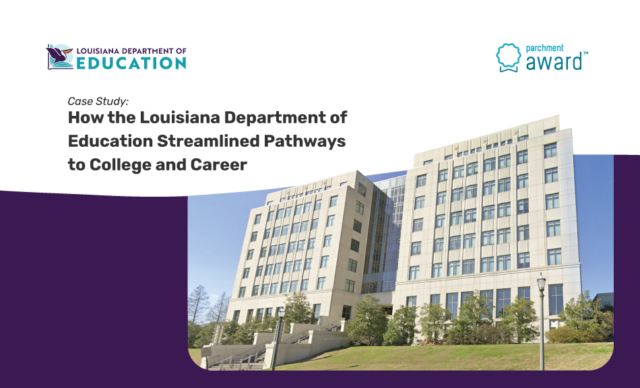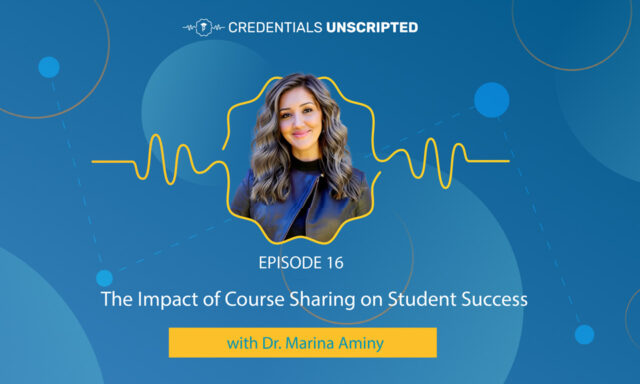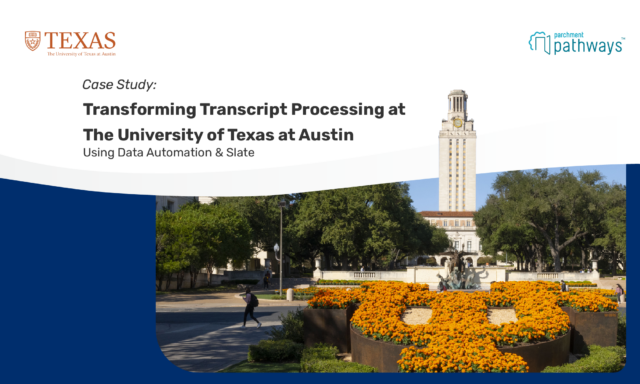“The more students use CLRs, the more they will be in demand, and we’ll see a broader acceptance by employers. Talk to other institutions about what they are doing. Let’s become a community. We’re not going back. We’re only going forward.” – Rodney Parks, Elon University
Our recent Parchment Connect 2021 virtual event featured not one, but two sessions about one of the hottest topics in higher education: the Comprehensive Learner Record (CLR). Here are some of the highlights!
Beyond the Transcript
According to Tom Green (AACRAO), transcripts are an invaluable tool for faculty, advisers, and registrars. However, they are not too helpful for students, simply confirming that a degree was awarded. The CLR is a more modern record, helping learners themselves and those with whom they share really understand learning outcomes.
CLRs won’t replace your official transcripts. Rather, these digital credentials supplement transcripts by focusing on what’s learned, not just what courses are taken. Unique to each institution, CLRs provide details that capture and verify what the 4-year college experience really means: skills, capabilities, activities, outcomes, High Impact Practices (HIPs), and other learning attributes. So, your learners can share their cumulative education experience with employers or other institutions.
Four Universities. Four Approaches.
Congratulations are in order for the University of Maryland Global Campus! Just recently, the large institution made their pilot CLR available for 5,000 MBA program students. This CLR focuses on co-curricular experiences, course program progression, and evidence of learning in individual courses. And captures academic badging as well. See press release.
Over the years, Elon University’s proprietary CLR framework has provided an extended transcript and beyond. Today’s CLR version is more straightforward and visual, with a co-curricular focus that will be expanded to include work experiences. According to Dr. Rodney Parks, the Elon CLR has created great resonance with the business community.
For Loma Linda University, Erin Seheuit explains that their CLR is experiential, containing leadership as well as national and international mission travel activities. The CLR is fully under student control and will be expanded to include institutional learning outcomes in the next iteration. For verification, the CLR data is routed through a workflow for approval.
At Temple University, the CLR tells a story that exemplifies learner success, illuminates their interests, and reflects their cumulative college experience. Initially, the university worked with the Fox School of Business to lay the foundation and framework to allow other schools to participate. According to Bhavesh Bambhrolia, the most important part is making sure there’s integrity behind the data.
All About Data
According to Tom Green, gathering CLR data can be challenging for a number of institutions, especially where learning outcomes intrinsic to the record may not be captured in the SIS along with courses, credits, and grades. He advises that you begin with identifying the types of data you have, determining where learning is taking place, and thinking about how to bring those pieces of data into the records you have.
How do you consolidate a digital CLR record? It depends. Do you already have a system with all the data, or do you need a tool to aggregate data from different sources? There are several approaches you can take, using your SIS, your LMS, an eCatalog system, a data warehouse, or a student life/affairs system (Handshake, Campus Labs Anthology). Or any combination therein.
Getting Started: Just Do It
All our session participants have a wealth of advice to offer, each from his or her unique perspective. (So, make sure to listen to both Connect 2021 recordings – it’ll be time well spent.)
The consensus is to start with what you have, where you are today. Understand the possibilities, but start with an initial version and evolve from there. Determine your end goal, and break it into steps that each have valuable outcomes.
Identify your champions and cheerleaders. Select a pilot group that “gets it” to participate. Link to the mission, identify key components, and map to the specific audience. And most important, remember that it doesn’t have to be perfect right out of the gate.
The Future’s So Bright: The CLR as a Generally Accepted Credential
When (not if) will the CLR become a generally accepted credential? Internal adoption starts with staff and students understanding the value. Then, as students share their CLR on social media and with employers and other institutions, demand will increase. Spread the word. Talk about CLRs every chance you get internally, and collaborate with other institutions and vendors.
“In general, adoption of digital credentialing as a whole has a way to go,” says Insiya Bream (UMGC), “but some of us are building that foundation. And that bodes well for what it can become.”
Parchment Can Help
Follow these 3 steps to go even further in your exploration of CLRs:
- View the entire sessions to hear from the experts how they implemented a CLR.
- Read more of our blog posts about CLRs:
- Learn more about Parchment Award – CLR Services. Then contact us to start the conversation.





